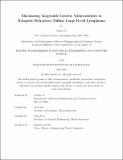Elucidating Targetable Genetic Vulnerabilities in Relapsed/Refractory Diffuse Large B-cell Lymphoma
Author(s)
Li, Audrey
DownloadThesis PDF (5.118Mb)
Advisor
Getz, Gad
Love, Christopher
Terms of use
Metadata
Show full item recordAbstract
Diffuse large B-cell lymphoma (DLBCL), the most prevalent form of non-Hodgkin lymphoma is marked by significant heterogeneity in its morphology, genetic irregularities, and clinical behavior. Current prognostic tools, including the International Prognostic Index and cell-of-origin transcriptional classifications such as germinal center B-cell-like and activated B-cell-like, do not adequately reflect DLBCLs complex nature. Front-line standard of care treatment predominantly consists of a regimen with cyclophosphamide, doxorubicin, prednisone, rituximab, and vincristine (R-CHOP); however, the relapse rate remains high, underscoring the need for improved diagnostic and therapeutic methods. In this comprehensive analysis, we investigated the genetic substructure of DLBCL in both newly diagnosed and relapsed/refractory cases, focusing on genetic abnormalities pertinent to relapsed settings and the immune microenvironment’s influence on therapy response. Our f indings revealed significant enrichment of specific genetic clusters, notably clusters 2 and cluster 5, which are associated with an inferior prognosis and high relapse rates following R-CHOP therapy. These clusters were characterized by distinct genetic alterations, including prevalent mutations in TP53, BCL2, and MYD88. The results of this study suggest that integrating detailed genetic profiling into the clinical management of DLBCL could significantly refine therapeutic approaches, tailoring them to the unique genetic backdrop of each patient’s disease. This approach promises to enhance the precision of prognostic assessments and the efficacy of subsequent therapeutic interventions, paving the way for personalized medicine in the treatment of DLBCL.
Date issued
2024-05Department
Massachusetts Institute of Technology. Department of Electrical Engineering and Computer SciencePublisher
Massachusetts Institute of Technology